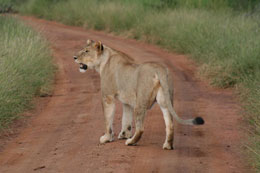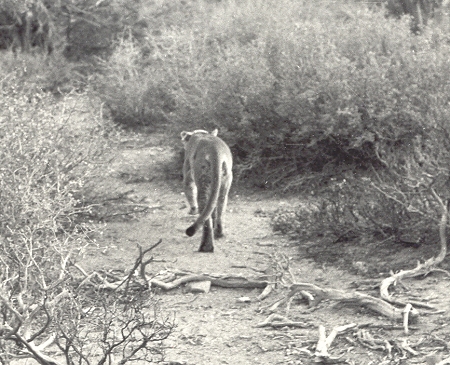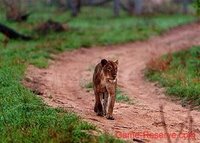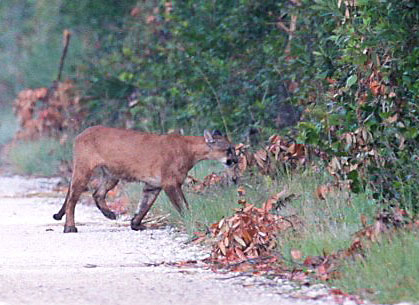North Georgia’s “Lions”
Posted by: Loren Coleman on June 13th, 2009
What is a “lion”? Is it an African lion? A maned lion? A female African lion? A mountain lion? A Detroit Lion? A Seibu Lion?

An African lion, female, directly above.

Lioness on a road, by Dick & Monique Smit, Henk & Liz Egbers, S.A.

An American panther, puma, cougar or mountain lion, gender unknown, directly above.

Lioness on the road at Uganda’s Queen Elizabeth National Park.

This cat is the “lion” of the Sunshine State, the “mountain lion” of the South, called a Florida panther.


Sometimes cryptozoologists need to be tested. Lion reports can throw a lot of things in the mix. Do not be distracted by foreground imagery, for in the background, as this visual analogy demonstrates, you might see the white-maned Seibu Lion or the blue Detroit Lion. All kinds of “quotes” from the authorities tend to deflect from the essence of the core reports.
Just look what’s going on with the sightings of North Georgia’s “lions”? What is happening down South, right now?
You do wish eyewitnesses and newspapers were a little more specific on what was being seen, sometimes. And officials gave more details. Sometimes they do, sometimes they do not.
Such an enigmatic situation has existed in northern Georgia, in the southeastern United States of America, for the past few weeks and days.
About three weeks ago, during the last week of May 2009, in the Lawton Drive area off Sardis Road, Gainesville, Georgia, two people claimed they were certain they spotted a “mountain lion” roaming undeveloped property near a tract of woods.
(Concurrently, a “brown lion” was being seen in Pleasant Grove, North Carolina on June 4, 2009.)
Then a “lion” was sighted on Georgia’s Highway 60 early Tuesday morning, June 9, 2009, near Gainesville, by a motorist.
Law enforcement authorities remarked to the media that if a “golden-brown lion” was strutting down the side of the road in the predawn hours near the Hall-Lumpkin county line, as a northbound driver reported to sheriff’s officials, it wasn’t native to this area. If it escaped from captivity, it wasn’t owned legally.
The report stirred sheriff’s officials in Hall and Lumpkin counties enough to conduct a search of the area with several deputies, and the owner of a nearby animal preserve was quickly contacted to make sure he had no escapees on the loose.
The Chestatee Wildlife Preserve, a facility off Ga. 115 that houses a number of exotic big cats, is about five miles from where the motorist said he saw the animal.
All the preserve’s animals, including two lions and five tigers, were accounted for, said Chestatee Wildlife Preserve owner C.W. Wathen.
Wathen said he went out with sheriff’s officials before dawn, armed with a tranquilizer gun, in case there was anything to the reported sighting.
“We didn’t see any signs” of a “lion,” Wathen said, but added that obvious indications such as paw prints aren’t always found. Wathen said the witness described the animal as being at least 6 feet in length. The animal “did not have a mane,” according to this one specific witness.
Hall County Sheriff’s Colonel Jeff Strickland said the witness was “adamant” that the creature he saw was a “lion.” (Thus, are we talking about an African lion? Or a mountain lion? It is never stated.) The man did not stop his car but called sheriff’s officials after reaching his destination shortly before 5 a.m., reported the Gainesville Times.
Hillary Hamilton of Murrayville, Georgia, told the Atlanta Journal-Constitution website that she saw the “big cat” near her house about 8:30 am, Wednesday, June 10, 2009, as she was leaving for work. Murrayville is in Hall County, about 10 miles southeast of Dahlonega, Georgia.
“I looked over there and I thought ‘what is that over there?’” she said.
Hamilton described it as “an animal the size of calf with a long tail on it, three to four feet long … and it was definitely a lion.”
The North Georgia woman said it was definitely not a coyote or fox. “No, no, no, no, no, no,” she said, “we have those in the area and I know what they look like.”
Hamilton said the animal “kept looking back at me and wagging its tail.” She said the animal walked into the woods toward a creek and she lost sight of it.
Sheriff’s office spokesman Jeff Strickland reported that deputies searched the area but found nothing. They also checked a game preserve about five miles from the scene but all the animals there were accounted for.
On Friday, June 12, 2009, authorities confirmed there had been another report from the Mount Vernon area.
“We have not found any kind of evidence at any of the locations where we’ve had the reports at,” said Department of Natural Resources Region Supervisor Ken Riddleberger.
Since people have been reporting they were “lions,” what does the state have to say about that?
“We don’t have any large cats that are native in the state of Georgia,” he said. Kenneth Riddleberger (whose name literally means “the handsome mountain dweller who solves mysteries”) told the media that if the animal is in fact a cat it is more than likely an escaped exotic cat or possibly an illegal exotic animal.
“We don’t believe we have any population of mountain lions or cougars in the state,” said Riddleberger.
The sightings, all between four and five miles apart, have all happened within the last week.
Perhaps there is a reason that the rather generic term “lion” is being used? Riddleberger said the descriptions of the animal vary, but the animal has always been described as a large cat.
There are no populations of mountain lions in Georgia, or for that matter anywhere in the Southeast, with the exception of Florida panthers, Riddleberger said.
Many times folks report things all the time, he said, and maybe they’re mistaking bobcats, large dogs or even house cats for lions, if they’re seeing them a distance.
“You never know what people might see,” Riddleberger said. “I wouldn’t discount it immediately. Some people may have certain animals in their possession, legally or illegally.”
“We know we don’t have any wild populations of large cats in Georgia,” Riddleberger said. “If there’s a large cat, it’s an escapee that someone has illegally.”
Back in September 2008, a large black panther weighing around 100 pounds was seen by a woman near a pond in Grovetown, Georgia, according to the Augusta Chronicle at the time. It stimulated a local biologist to make an interesting observation.
Vic VanSant, a biologist with Georgia’s Wildlife Resources Division mentioned they do get a number of phone calls from people that claim to have seen lions and large cats every year. He remarked that they even captured a mountain lion in 1995, inside the Clarks Hill Wildlife Management Area. It turned out it was a known animal that was part of an experiment with transplanted mountain lions in Florida. This particular animal made it’s way into Georgia. Intriguingly, it did not generate a single sighting report.

Your assistance is critically important in supporting the museum. Please…
Contributors of $60 or more received a personally autographed, inscribed copy of Tom Slick: True Life Encounters in Cryptozoology.
Thank You.
About Loren Coleman
Loren Coleman is one of the world’s leading cryptozoologists, some say “the” leading living cryptozoologist. Certainly, he is acknowledged as the current living American researcher and writer who has most popularized cryptozoology in the late 20th and early 21st centuries.
Starting his fieldwork and investigations in 1960, after traveling and trekking extensively in pursuit of cryptozoological mysteries, Coleman began writing to share his experiences in 1969. An honorary member of Ivan T. Sanderson’s Society for the Investigation of the Unexplained in the 1970s, Coleman has been bestowed with similar honorary memberships of the North Idaho College Cryptozoology Club in 1983, and in subsequent years, that of the British Columbia Scientific Cryptozoology Club, CryptoSafari International, and other international organizations. He was also a Life Member and Benefactor of the International Society of Cryptozoology (now-defunct).
Loren Coleman’s daily blog, as a member of the Cryptomundo Team, served as an ongoing avenue of communication for the ever-growing body of cryptozoo news from 2005 through 2013. He returned as an infrequent contributor beginning Halloween week of 2015.
Coleman is the founder in 2003, and current director of the International Cryptozoology Museum in Portland, Maine.










the handsome mystery solving mountain man is sticking to his official instructions. “there are no large felids in this area”. which, imho, is BS. possibly, in the best interest of any large cat, though. locals could get worried or start looking for them.
as for the word “lion”, i am not aware of any local southern dialect that would typically use the word “lion” to describe a north american mountain lion. from the Smokies, through Appalchia, to the Shenendoah, i hear mountain lion or cougar. on the coast, i hear panther or puma. if you ask me, considering the insistance and specifity of the language used in all area dialects, and the fact that EVERYONE knows what you’re talking about, and they continue to talk about them, the animals ARE here. it is a surprisingly hot topic amongst outdoorsman.
if they just say “lion”, i feel they are talking about an African lion or similar exotic.
“bass” is another animal like this. depending on where you live you caould be talking about 10 different freshwater or marine species. kind of annoying!
Through the years I have lived in several locations throughout Georgia, mostly in rural areas. The standard ‘there is no population of lions (cougars) in Georgia’ is mouthed every time someone reports one. I have spoken with hunters and fishermen who have seen and collected scat, hairs, footprints, photographs (how do we know where this was taken?) and who have seen mothers with cubs. The standard reply is decreed from Atlanta, which is another world entirely from the more rural areas. Unfortunately, Atlanta also controls who is hired, fired and promoted.
So, do I believe there is a population, perhaps scattered throughout the state, of cougars in Georgia? Yes, even though I’ve never seen one. My daughters, however, who both graduated from Georgia Southern University (the youngest with a degree in biology) did see one, on several occasions.
The official position on cougars in Georgia is not that far from the official position on Sasquatch anywhere.
Ms. Hamilton said the cat was looking back at her and “wagging its tail”. she’s lucky. if that cat was standing its ground and ticking its tail, then it was pondering its next move. she is fortunate that it decided to pad off into the wood instead of turning around.
in addition, a cougar wouldn’t have been caught dead on the ground like that. she wouldn’t have seen him. this also points to escaped exotic.
I myself encountered a “mountain lion” in the wild in Georgia in what I believe was 1988. It was in Snellville, a town not too far from Atlanta. The area around my subdivision was heavily wooded. And I say “mountain lion” because that is indeed what I have known most Georgians to call them, as I believe it’s a pretty common misconception here that such animals are a natural part of the Georgia ecosystem.
I had a friend whose house was completely surrounded by forest. One day he told me he had been seeing a female mountain lion stalking through the woods outside his home. He brought me down towards the creek, and after about an hour, sure enough I saw it. It was walking very slowly through some brush across the creek. It took about two minutes or so to pass into some foliage and vanish out of site, but midway through its treck it stopped and looked directly at us. It was definitely a fully grown cougar. I remember it vividly to this day. I can’t say if it was female or not.
I was thrilled to have seen it, so I rushed home and told my parents, who naturally didn’t believe me. My friend told me that the animal had escaped from a nearby wildlife preserve, the Yellow River Game Ranch. What’s odd about this story is that the Game Ranch only ever had one or two big cats in captivity at the time. I visited it frequently and neither animal was ever missing, nor were there any such reports in the media. So truth be told I have no idea where the animal came from. Nor did I ever see it again. I would have, too, if it had stayed in the area, because I played in those woods on almost a daily basis. I was pretty fearless as a kid, so the idea of a big cat in those woods never daunted me in the slightest.
Was it an escaped exotic? Maybe. Either way it was a pretty memorable childhood experience. 🙂
I totally understand confusing the African Lions with the Detroit Lions. Neither one can plan football.
historically, there are several species that were common throughout the precolonial southeast, all the way to the coast, such as bison, bear, elk, wolves, and parakeets. these animals are no longer referred to in local dialects (except bear more inland). the gullah speaking locals talk of the “big ol’cat”, but never of wolves, bison, elk, or parakeets. cougars would be linguistically extinct by now if they didn’t truely exist in the areas.
sorry i keep adding to this thread but i find words and wordplay interesting.
How long is the history of these cats presence in the area? Are they spotted since the Europeans entered the scene or are they known since before?
What makes a lion? They live in social groups while other cats live in solitude.
I think that is the distinction that divides cats into lion or not.
Maeko- I live in Tennessee, and back in the early seventies (about ’71 perhaps) I was absolutely certain I spotted a Carolina Parakeet. I recall reporting it to the local Audubon chapter, of course with utter unbelief. A- I was a kid (about 12), and B- it was known to be extinct for decades, so I couldn’t possibly have seen it.
That’s my one and only crypto-encounter. Did I truly see one? At the time I was absolutely certain. The size, the color, the shape, they were all correct, and unlike any bird native to the area. I only saw the one, sadly.
As to playing with language, there is also the traditions of the Uncle Remus stories, with ‘Br’er Bear, Br’er Fox and Br’er Rabbit. I don’t recall there being other critters used as characters, I mean there was to Br’er Buffalo or Br’er Wolf.
Since there are “Florida panthers” that are closely related to the western cougars, they must at some point have lived everywhere in between, including places like Georgia. So what’s the deal? Are they believed to have been hunted to extinction by farmers, or to have died out naturally? If so, when?
I have relatives of all ages scattered all across the South, including a couple dozen in Georgia.
The really old folks, those who have lived all their lives in rural mountainous areas, all call pumas “panthers” (pronounced paint-ther). The younger people -the TV generations- usually call pumas “cougars” (no doubt influenced by nature shows on TV). Occasionally you will hear someone refer to “mountain lines” (you’ll never hear it pronounced “lion” by a native 🙂 ).
Pumas ranged North and South America from end to end, except for extreme northern Canada. Their former range also extended from the Atlantic coast to the Pacific. Georgia was part of the range; the Okeefenokee Swamp in southern Georgia was long though to be hold one of the last surviving natural populations of Florida panther, formerly known as Puma concolor coryi, although none were confirmed there in an extensive recent survey. The Appalachian Mountains and central and western Georgia were home to the Eastern puma, Puma concolor cougar (all North American cougars are currently considered to be of this subspecies).
Pumas are widely considered by most authorities -certainly by most state F & W Departments in the East- to have been “extirpated” from the eastern US by the early 20th century. But natives beg to differ: there have been hundreds of sightings and other reports from that time to this, and not all of them are misidentifications.
Maeko:
Great comments regarding identification by language.
And I love “lion” and “panther” sightings. Great post, Loren.
I have lived in Georgia my whole like, and most people I know would say, “panther.” If someone were to tell me that they just saw a “lion” in Georgia, I would envision the African, maned kind.
I lived in south Georgia for a long time, and several people in my family have seen large cats (black twice, and brown twice). My mother and I saw a dead panther on I-16, and my parents saw a dead juvenile-sized panther on the same road (but different location) 10 years later. When my wife and I drove by the same spot 2 days later, we never saw a body. Yet, I have never seen any reference to roadkilled panthers (whether identified as wild or escaped pets) when trying to research ABCs in Georgia.
i think that this “lion” as it is called is perhaps a member of the lynx family as appose to the lion, we can see that the creature has pointy ears and a short stubby face just like a lynx so perhaps someone kept it and perhaps it is a typical “escaped pet” story